West Kildonan Collegiate
Deepens Understandings of Indigenous History, Culture and Teachings
As part of our school plan for the past number of years, we have adopted the school goal of deepening understandings and integration of Indigenous perspectives. We include this goal in our staff meeting agendas and prompt initiatives, support PD in this area and celebrate publicly when Indigenous related events occur. WK now begins each day by recognizing its location on Treaty 1 land. This small step has led to questions arising around this recognition that have led to further dialogue and deepening understandings of history and treaty relations/responsibilities. The following stories hi-light a variety of initiatives over the past year and into 2017-18.
Orange Shirt Day
For the first time in history, WK participated in Orange Shirt Day on Friday September 30th, 2016. Orange shirt day is a national opportunity for Canadians to recognize the harmful impact of residential schools on Indigenous peoples and begin the work of reconciliation as outlined by the Truth and Reconciliation Commission. Across the 7 Oaks School Division, teaching staff and students wore orange that day and did a variety of activities to promote the idea that EVERY CHILD MATTERS, the theme of the day. At WK the art classes helped create a giant t-shirt with slips of paper created during Teacher Advisory Group meetings illustrating how every child matters. The work of understanding history, deepening understanding and respect for Indigenous culture and making a special effort to support youth in CFS care continues at WK. Google ORANGE SHIRT DAY for further information and join us in wearing orange across the city this year on September 29th.
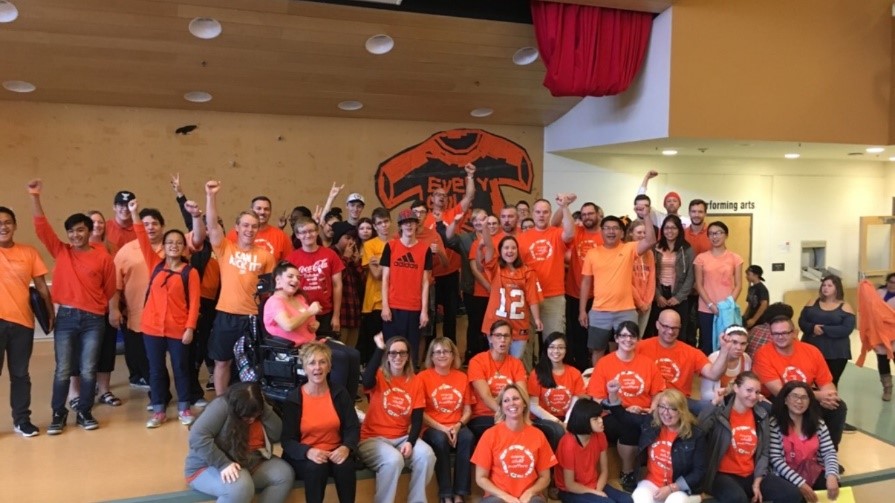
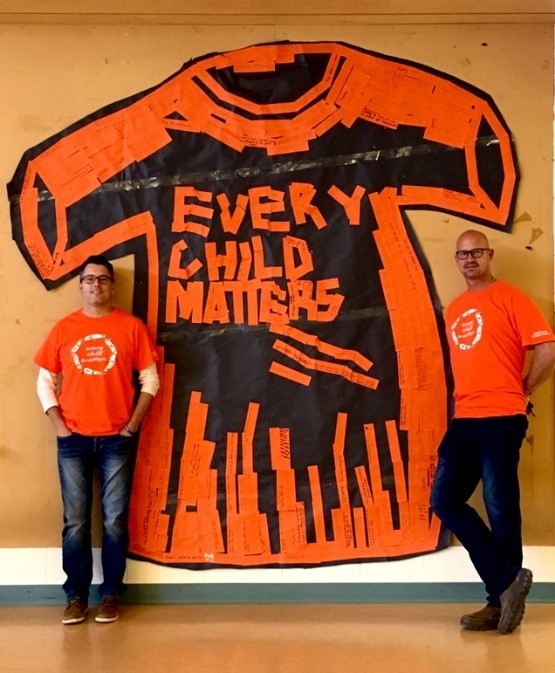
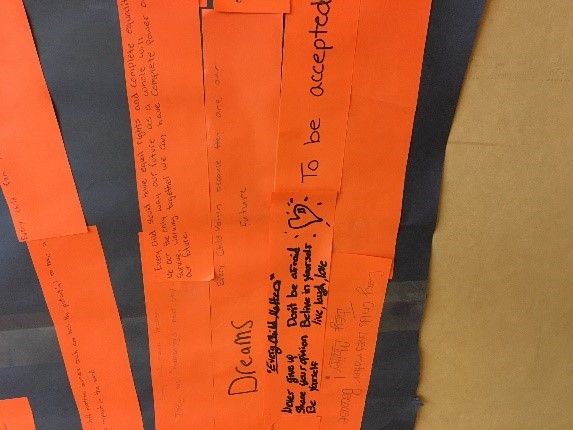
West Kildonan Collegiate pilots SLAM-the Sustainable Living Academy Manitoba:
Reconnecting to Nature and Indigenous World Views
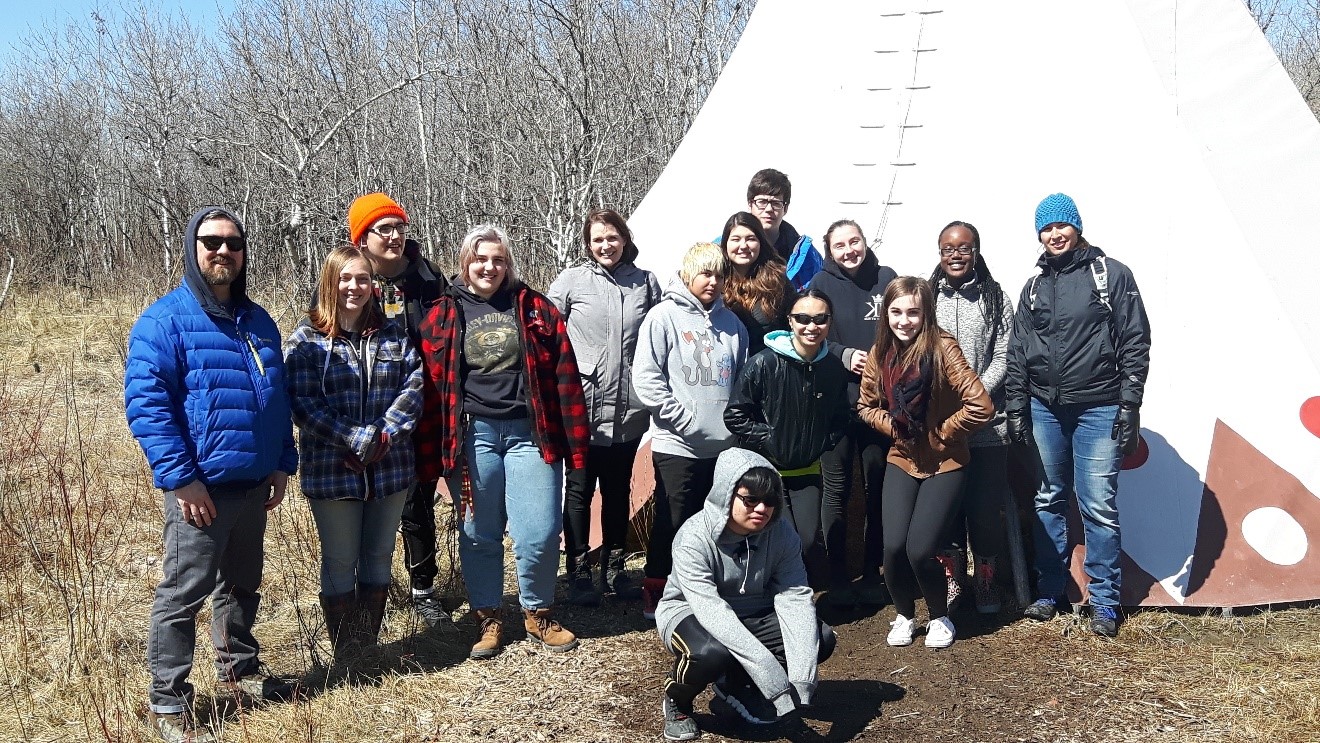
The Sustainable Living Academy Manitoba (SLAM) is a new half-day program for grade 11 and 12 students, within West Kildonan Collegiate and first opened in February 2017. Students learn valuable leadership skills for positive change in our community through Internships related to sustainability, community, environmental conservation and culture. One of the goals of this program is to support the transition towards a whole-school approach to sustainability by allowing students to be the ambassadors for change.
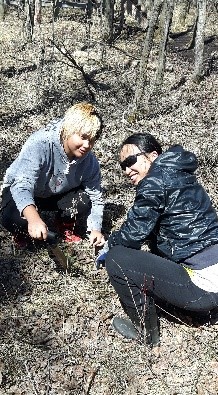 For thousands of years, Indigenous people have known this land and have had a deep connection and relationship to the plants, animals and fungi that live here. Indigenous ways of knowing teach us important lessons on how to live in a sustainable manner, and this wisdom is more important than ever. These long established deep connections to nature within existing ecosystems, have allowed for diverse Indigenous communities and cultures that should serve as an important lesson to how we could live more sustainably today. Indigenous world views teach us that we are not in fact separate from nature, but we are a part of it, and that the interconnectedness of all species is essential to our own wellbeing.
For thousands of years, Indigenous people have known this land and have had a deep connection and relationship to the plants, animals and fungi that live here. Indigenous ways of knowing teach us important lessons on how to live in a sustainable manner, and this wisdom is more important than ever. These long established deep connections to nature within existing ecosystems, have allowed for diverse Indigenous communities and cultures that should serve as an important lesson to how we could live more sustainably today. Indigenous world views teach us that we are not in fact separate from nature, but we are a part of it, and that the interconnectedness of all species is essential to our own wellbeing.
Young people today need to rediscover the beauty and wellness that comes from reconnecting to the natural world. Nature is a good teacher, but it requires more than the occasional visit outdoors. SLAM students value the experience of learning outdoors and take pride in being stewards of the land. Some of the outward bound activities of this past year have included; tree planting, environmental studies, riverbank clean up, soil sampling, snowshoeing, wildlife surveys, and the joys of gardening. 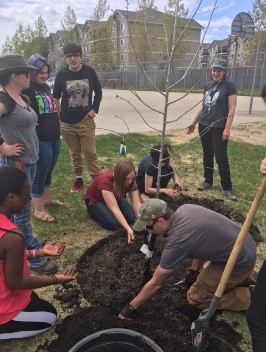 We also planted 17 new trees on our school grounds, each one representing one of the United Nations Sustainable Development Goals. This project was made possible by the generous contributions of a Tree Canada #Canada150 “Tree to Our Nature” grant awarded in March, 2017. We planted a variety of native tree species such as; White Spruce, Manitoba Maple, Basswood and Clump Paper Birch. With the help of our divisional Elder, students have received Indigenous teachings of why trees are forever giving, how they are used for medicinal purposes and ceremony, production of food (Maple syrup), and integral to wellness.
We also planted 17 new trees on our school grounds, each one representing one of the United Nations Sustainable Development Goals. This project was made possible by the generous contributions of a Tree Canada #Canada150 “Tree to Our Nature” grant awarded in March, 2017. We planted a variety of native tree species such as; White Spruce, Manitoba Maple, Basswood and Clump Paper Birch. With the help of our divisional Elder, students have received Indigenous teachings of why trees are forever giving, how they are used for medicinal purposes and ceremony, production of food (Maple syrup), and integral to wellness.
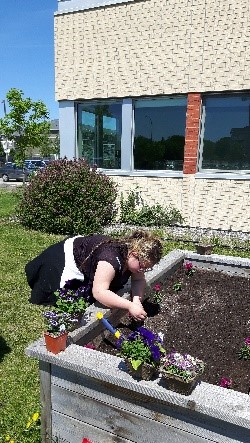
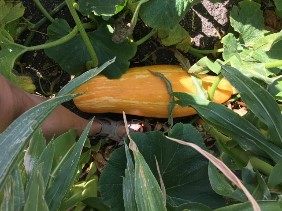 This past summer, our community circle garden was a success, and students chose to grow a wide variety of food such as; carrots (orange and purple), parsnips, green beans, lettuce, spinach, mesclun, beets and corn. We also planted potatoes, sunflowers, celery, garlic, onions, leeks, swiss chard, tomatoes and green peppers. Student internships and dedicated seniors cared for the garden over the summer months. Most exciting of all, SLAM students had the incredible opportunity of reviving an 800-year-old Indigenous squash in our Seven Oaks School Division community. We were gifted nine of these ancient seeds this past winter from Brian Etkin, a horticulture enthusiast and from students at the Aboriginal Community Campus. These squash were thought to have been extinct, date back 800 years and were selectively bred for thousands of years by the Menominee Nation of Wisconsin. They were reintroduced after first being discovered at an archaeological dig at an ancient Indigenous site. After great care in germinating the seeds indoors, they were planted in our circle garden in front of the school. We have now been learning about seed saving, so that the seeds may be used in future.
This past summer, our community circle garden was a success, and students chose to grow a wide variety of food such as; carrots (orange and purple), parsnips, green beans, lettuce, spinach, mesclun, beets and corn. We also planted potatoes, sunflowers, celery, garlic, onions, leeks, swiss chard, tomatoes and green peppers. Student internships and dedicated seniors cared for the garden over the summer months. Most exciting of all, SLAM students had the incredible opportunity of reviving an 800-year-old Indigenous squash in our Seven Oaks School Division community. We were gifted nine of these ancient seeds this past winter from Brian Etkin, a horticulture enthusiast and from students at the Aboriginal Community Campus. These squash were thought to have been extinct, date back 800 years and were selectively bred for thousands of years by the Menominee Nation of Wisconsin. They were reintroduced after first being discovered at an archaeological dig at an ancient Indigenous site. After great care in germinating the seeds indoors, they were planted in our circle garden in front of the school. We have now been learning about seed saving, so that the seeds may be used in future.
There is a tremendous need for all children to know the natural world on a very personal level, and if we are to achieve this, schools must embrace this in their vision and practice. If we can keep that spark well into the high school years, we will have citizens that would never dream of damaging what they have loved since birth.
By Heather Eckton
Drum Making in Drafting Class
At West Kildonan Collegiate, in the 2016-2017 school year, Mr. Asher’s Grade 9 Drafting class built aboriginal drums. Although curriculum outcomes were attained through the design and creation of their own drums, students also learned about another culture during the completion of their assignment. In addition, guest speaker David Boulanger was an invaluable resource for direct knowledge. Mr. Boulanger visited the class and explained the legend and significance of the drum in Anishinaabe culture.
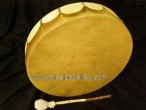
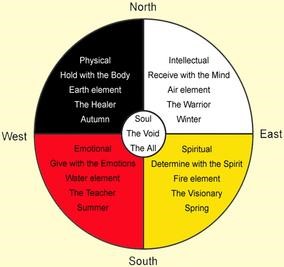
WK Teacher Rob Schrofel integrates Indigenous history/contemporary issues into all of his courses. Rob shares the following:
“In American history we begin the course by exploring what was in place in terms of traditional cultures prior to the arrival of Europeans. Throughout the course we look at the impact that colonial policies and practices have had on the Indigenous societies. Some of the activities we do are to prove Columbus perpetuated a genocide on the Indigenous peoples by using primary source documents of early Spanish explorers and the UN definition and criteria to prove a genocide. We also look at the relocation of the Cherokee people through an activity called Samuel's memory and use the US Constitution to show how many principles of the Constitution were violated with this policy.
In Grade 12 Law, we look at the Indigenous contributions to the legal system, including the Treaty relationship, the legacy of Indigenous cultures on the legal system, such as the Haudenesaunee Confederacy and the use of consensus for decision making, and how the Courts are using traditional concepts when sentencing offenders, such as sentencing circles and victim-offender mediation.
In Grade 10 geography, we teach students that much of the "new solutions" to being environmentally sustainable are actually "traditional practices" from the Indigenous peoples.
For example, the concept of crop rotation was practiced to restore nitrogen to soils and with the move to organic farming, this method is becoming more common place. As well, we explore documentaries that explore the concept of "caretakers of the land" in order to embed the concept of sustainable development.
In grade 11 history, we look at the role Indigenous peoples have played in shaping the Canada we see today, as well as look at how the issues of today are often unresolved issues from history.
Overall, in all the courses I teach I use every opportunity presented through content, curricula, news items, or conversations to counter myths and misconceptions surrounding the Indigenous - Non - Indigenous relationship, the need for and concept of reconciliation, and to get the Aboriginal perspective into the narrative.”
WK Band Teacher Art Zuke shares initiatives music students are part of:
“Last year I took time with all West K Band Students to view Gord Downie's "The Secret Path", which led us to further conversations about the multi-generational impact of Residential Schools, and the power of music to tell a story and open people's eyes.
The year previous West K Bands prepared and performed a piece called "Trail of Tears", which was inspired by the brutal American story of the forced migration of the Cherokee Nation. Band students learned about this tragic American history, and connected it to the similar Canadian story of our government's relocation of Inuit people from the fertile lands of Northern Quebec to the barren lands of the High Arctic. After connecting to the Canadian story, we "Canadianized" this American composition by adding a dark sounding "God Save The Queen" Canadian element to the piece through added choral parts.
This year we started the year by dedicating our first hour of class to connecting to each other: ONLY connecting; not talking about course material. We sat in a circle and each of us shared a little something about what makes us happy (moving from the East to the South, to the West, and to the North), creating a pool of happiness in the circle that could serve to connect us as we move on to our music-making. During this year we will also be connecting the four directions Medicine Wheel and their meanings to the cycle of growth through students' four years in the West K Band Program.”
ELA Teacher Myckaila Grimes Deepens Indigenous Understandings
Through studying literature by and about Indigenous people, students become aware of the rich, and often troubling, history of Indigenous peoples that is inextricably woven into all of our lives today. Novel studies of April Raintree, Indian Horse, or close readings of Sherman Alexie’s narrative essay “Indian Education” allow students to make personal connections to characters and participate in in-depth discussions about Indigenous history, culture, the residential schools legacy, and more.
These literature studies not only help non-Indigenous students to gain an understanding of Indigenous perspectives, but it allows Indigenous students to see themselves represented in the curriculum, not just as numbers or statistics, but as whole characters in a story. It shows them that they are significant and worthy of our time and understanding. Outings to plays like HUFF, which portrayed the lives of two brothers who grew up amidst addiction, abuse, and trauma on a reserve, can also facilitate powerful and emotional learning opportunities.
In English classes, we often try to step into other people’s shoes. We strive to make connections to characters and see in them reflections of ourselves. Therefore, it is so important that we do not forget to incorporate Indigenous perspectives, characters, and literature in these studies as well.
The 8th Annual 7 Oaks Graduation Pow Wow
This year’s 8th annual graduation pow wow was amazing. Over 100 grads and over 350 pow wow club dancers from 20 of our schools enjoyed an evening of feasting, singing, dancing and drumming. Grads were honoured with their own pow wow t-shirt and a certificate marking their participation. The pow wow took place in the new gigantic Winnipeg Soccer Federation complex at 770 Leila. The venue was packed with more than 1500 people, all drawn into the heartbeat of the drums and the colour of the pow wow dancers. Children played happily, the food was excellent and many families watched as their sons and daughters participated in this wonderful Indigenous celebration. The evening ended with a Canada 150 In a time of Reconciliation celebration with a rock-n-roll stage and incredible fireworks show to cap off the evening. We will once again be part of the planning and participate in the 9th Annual Graduation Pow Wow.
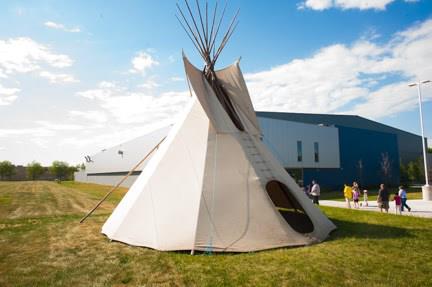
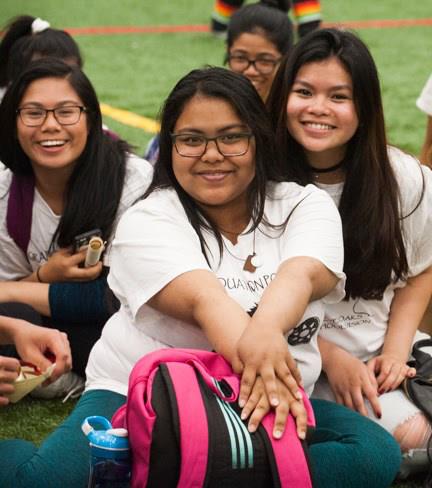
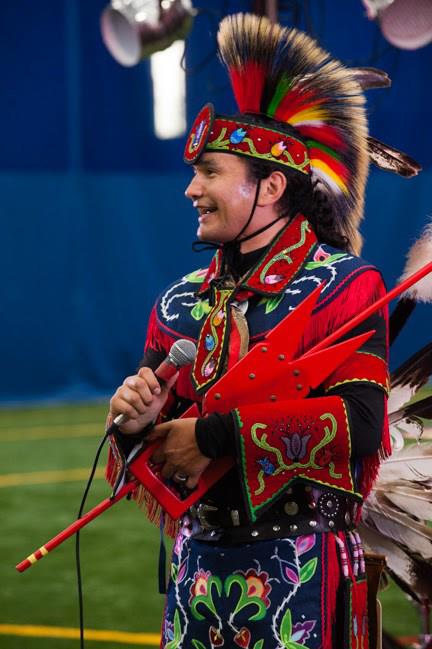
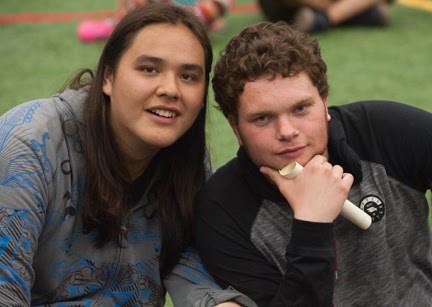
New Staff Member at WK talks about his beginnings at our school…
My name is Eric Johnson and I come to West Kildonan having spent the last twelve years teaching at Leila North. As I transition from Middle Years to the High School level I am excited to explore the opportunities at West Kildonan. My educational interests include Indigenous survival skills, sustainable development and environmental education and look forward to finding ways to incorporate those interests at West Kildonan. I’m a firm believer that hands-on learning leads to deeper understanding and a respect that can be overlooked when learning from texts. As a Geography and History teacher I intend to make use of every opportunity to explore the many contributions Indigenous people have made to Canada’s history. Finally, it's a pleasure to be coaching with Wolverine football this season.
WK Hi-lights from the past two years…
Cultural Credit Program
It’s been a busy time for the Cultural Credit Learners. Our group of 8-10 students have been able to partner with three other schools within Seven Oaks school division and participate in making new friends and partner-ships with Maples, Garden City and Elwick. When we are on our own we meet together every Thursday to smudge and learn about our culture. Lately we have been jumping on a bus driving 40 minutes north by Lac du Bonnet and attending a tradition-al cultural camp to learn from our Elders through storytelling and drumming. It has been a great start to the year and our West Kildonan Collegiate Students are on their way to making their own personal drums. We will continue this process throughout the rest of December. Happy Holidays from the cultural credit students.
Written By: Kristin Erickson
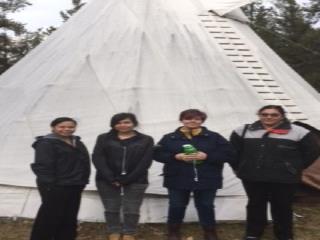
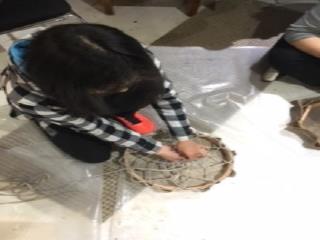
WK Equity Day Conference
By Heather Eckton, Teacher
A Great Way to learn about each others heritage and discuss topics like racism
The Equity Conference was hosted on April 28, 2015 at West Kildonan Collegiate. Over 350 students from over 13 different classes attended. The day began with a welcome from elder Mary Courchene and an address from Kevin Lamoureux, the key-note speaker. Indigenous performers, The Asham Stompers and West Kildonan Indigenous group were phenomenal and breakout sessions with several community leaders were eye opening. Inspirational individuals such as Michael Champagne, Jenna Wirch, Bernadette Smith, Nancy Macdonald, Diana Bernardo, Lindey Courchene and the Silent No More students from Maples Collegiate led breakout sessions with youth from grades 9-12. The conference also included breakout sessions which were designed to be small, so that students would feel comfortable participating in the discussions, and guests could share their stories in an intimate setting.
Students were asked to share their reflections of the day, and here is some of what they had to say:
“I took a lot away from this experience including not judging people by their appearance. It has really opened my eyes and to know that [racism] happens a lot and very often, took me by surprise. I didn’t think it was that bad of an issue but after this, I definitely view equity differently.”
Grade 9 student
“In my opinion these conferences are very educational and helpful. I think they really show you what you may have not noticed before and also show you how others feel.”
-Grade 9 student
“I really learned about equity and otherness and how racial discrimination affects the world. This changes the way I view other people and makes me feel compassion. I’ve learned to not judge people by their appearances.”
-Grade 10 student
“I’ve learned to] step up and help others that are being treated unfairly and being disrespected.”
-Grade 11 student
“From this experience I learned the difference between equity and equality. It has changed my way of looking at people by what they are outside. I hope that racism would completely stop because I have learned how people experience racism.”
-Grade 9 student
“I learned that there are more cases of racism compared to what I thought. I learned that we should take racism seriously. That there are a lot of cases of racism that affects the physical and mental state of a person.”
-Grade 9 student
“I honestly learnt about everything, some of the things that I learnt about were the Indian Act and that Canada is the last place, that has it. I also learned more about Nancy Macdonald's article and why she wrote it the way she did.”
-Grade 9 student
“I got to learn what equity means and that saying “equal” or doing what is equal is not always right. We need to pay more attention to what’s happening in our surroundings, and to not judge people and get to know them first.”
-Grade 10 student
“This conference has totally changed the way I look at equity and I don't think that my view on this topic would have changed if it wasn't for Michael Champagne and Nancy Macdonald because before this conference I didn't know what some people are going through, that it's real and it's a problem that needs to be solved.”
-Grade 9 student
“I was aware of the issues happening in the North End and had no opinion on those situations of otherness and racism. But after the conference, I now have an opinion and a higher respect of Aboriginal people.”
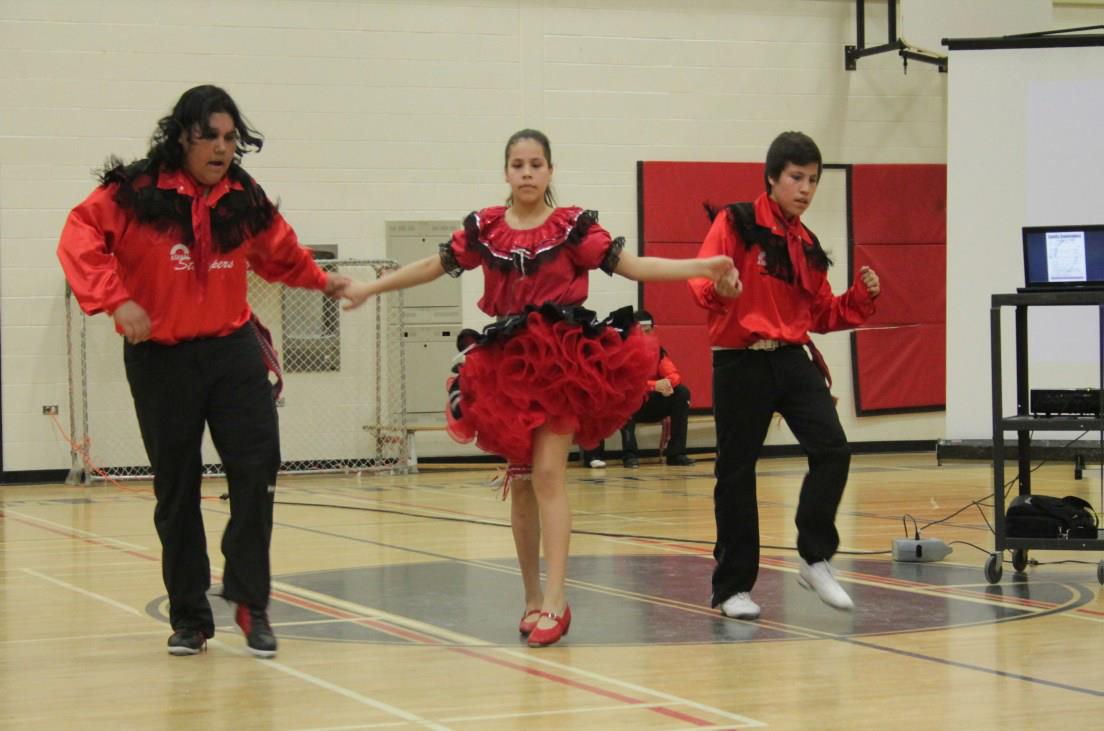
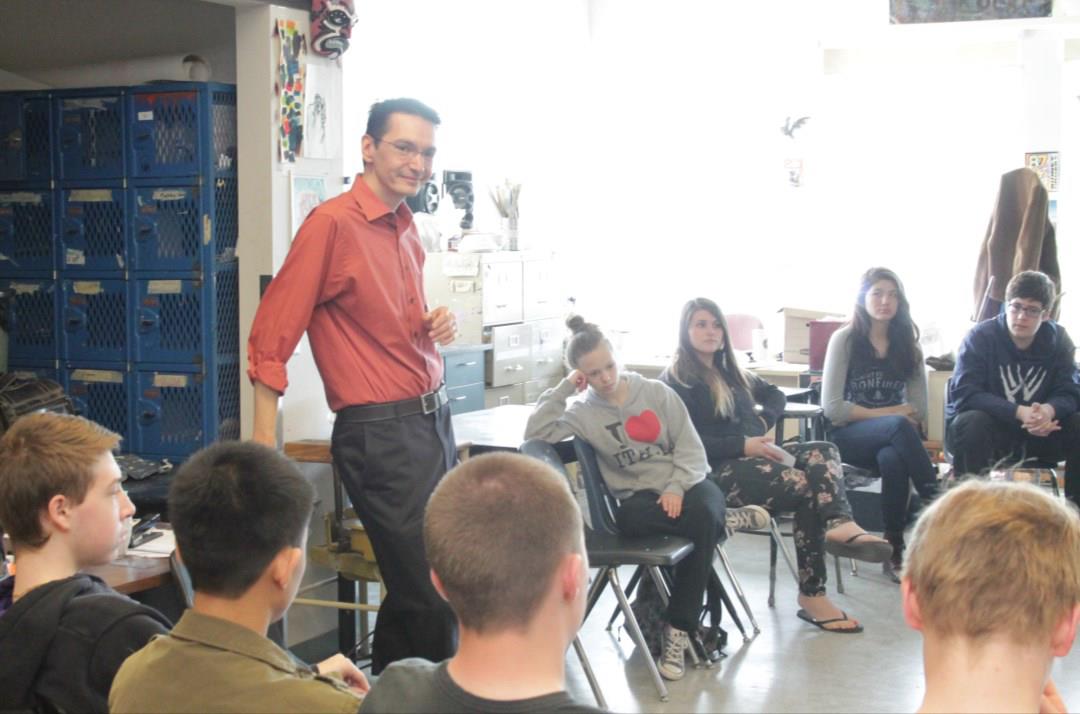
Community Circle Garden
By Sharon Nowrang, Teacher
Community gardens are part of a growing trend in self-sufficiency and the desire to eat locally grown produce. Throughout history there have been periods where communities began local gardens to provide people with healthy food. Today, community gardens provide healthy food, exercise and an opportunity to express cultural traditions. The West Kildonan Community Circle Garden is a way to reach out to the community to provide fresh grown herbs and vegetables. Our garden is grown in a circle that represents the Medicine Wheel. The Medicine Wheel represents harmony and connections and is considered a major symbol of peaceful interaction among all living beings on Earth. The logs that are used for the benches are repurposed Elm Trees that were cut down due to Dutch Elm Dis-ease. The trees could be over a hundred years old!
The Community Circle Garden is a teaching tool with each of the four quadrants reflecting the First People and the waves of immigration that occurred after. There are a variety of ways that teachers and community members can utilize our garden. The 4 quadrants are the following:
North West Quadrant - contains natural ground cover; plants, grasses, berries, and medicines indigenous to Manitoba and North America
North East Quadrant - contains plants and vegetables grown by First Nations peoples; Three Sisters (beans, corn, squash), tomatoes, and potatoes
South East Quadrant - contains European introduced vegetables; carrots, onions, lettuce, beets, etc.
South West Quadrant - contains contemporary multi-cultural herb and vegetables; garlic, spices, peppers, etc.
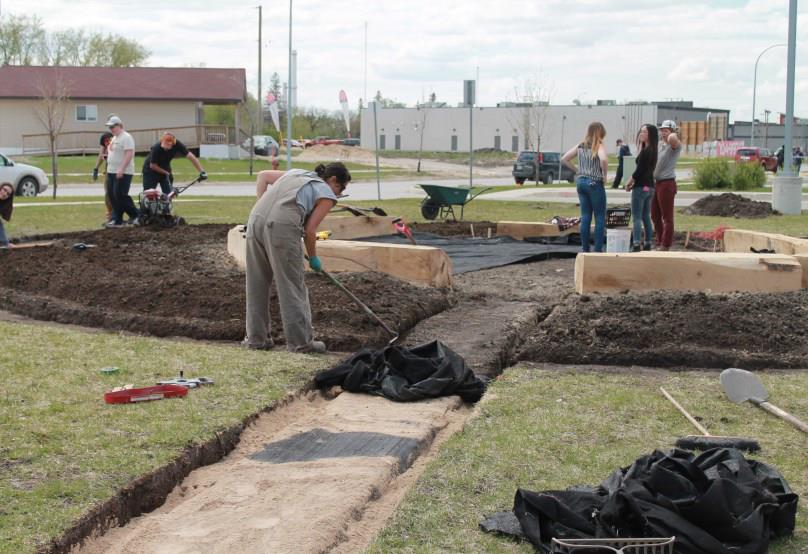
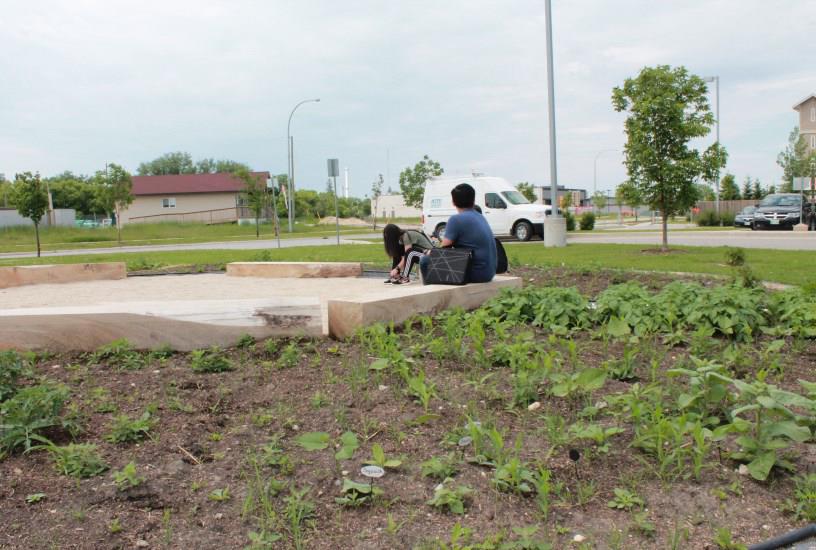
Aboriginal Blanket Simulation
By Kevin Block, Teacher
On May 23,during Period E Day, Mr. Schrofel's and Mr. Block's grade eleven history classes took part in the Aboriginal Blanket Activity. This activity is a simulation model which seeks to demonstrate the various impacts that colonialism has had and continues to have on Canada's indigenous peoples. Students took part in a role play, seeing and feeling the history of our country from the Aboriginal perspective. Students were able to make connections to the history that they have learned all semester in class and see it all "play out" from precontact to the battles of our indigenous populations today. Students were able to gain an understanding of how exposure the various diseases, the flood of European settlers, the reserve system, residential schools, to name a few, all but wiped out the culture of our indigenous peoples. Prime Minister Harper stated in his residential schools apology, "the burden is properly ours as a Government, and as a country." In the end, it is hoped that our students understand that statement as we move forward.
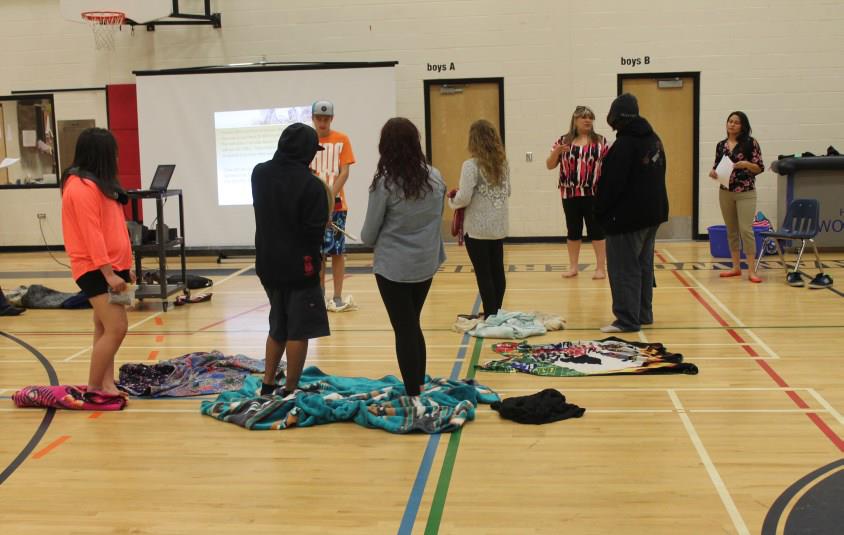
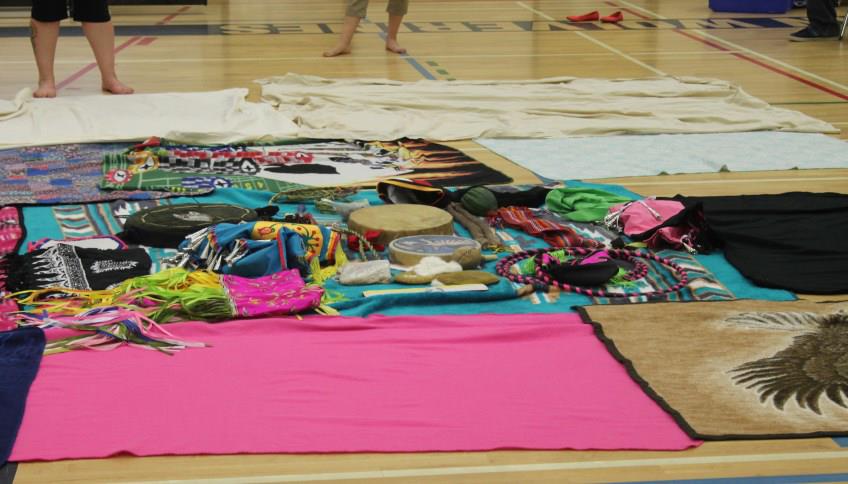
Sweat Lodge Experience
By Brianna Knott, Grade 9 Student
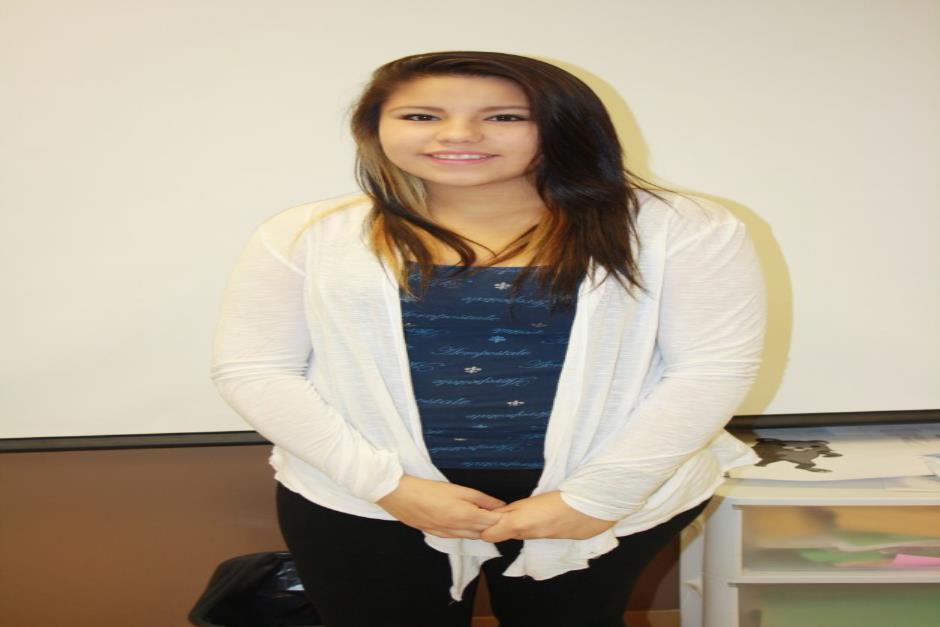 On Thursday October 24, for all period day I went to a sweat lodge at the thunder bird house on Higgins and Main Street, with my tourism teacher Mrs. Troudeu, at the sweat lodge you go into this little round tent(sweat lodge) that’s made out of sticks and tarp/blanket or some-thing, over it, the lodge is 10x10 I’m pretty sure, they said they can fit at least 30 people in there when we got there we stood outside for about half hour talking about the 7 teachings in the aboriginal culture, then after we did a smudge well the people who wanted to, then we got changed. The girls wore skirt and the guys wore shorts and we had to wear something dark, then we did a prayer and after threw tobacco in the fire to pray for what we wanted to pray for. Then we went into the lodge, before they closed the door they put 7 rocks in to represents the 7 teachings, and every time they would open the doors they would add 7 more rocks, and they had 4 rounds for each sweat every round is about 10-15 minutes after they put the rocks in they would put sage on them, then they would close the doors and put water on the rocks so we could “sweat” to start, then during the 10-15 minutes they would sing 2 songs, I’d say going to the sweat lodge was a pretty cool experience, considering it was my first time going to one, when I went into the lodge I didn’t know what was really going on and then when they closed the door it was pitch black it was like my eyes were closed, it took a few minutes for me to get used to it, it took about an hour and a half for the whole sweat, I ended up staying in the lodge the whole time, then some people ended leaving when the round was over but then some came back in the next round, when it was over I didn’t want to leave I felt so relaxed, it felt like I was cleansing my body.
On Thursday October 24, for all period day I went to a sweat lodge at the thunder bird house on Higgins and Main Street, with my tourism teacher Mrs. Troudeu, at the sweat lodge you go into this little round tent(sweat lodge) that’s made out of sticks and tarp/blanket or some-thing, over it, the lodge is 10x10 I’m pretty sure, they said they can fit at least 30 people in there when we got there we stood outside for about half hour talking about the 7 teachings in the aboriginal culture, then after we did a smudge well the people who wanted to, then we got changed. The girls wore skirt and the guys wore shorts and we had to wear something dark, then we did a prayer and after threw tobacco in the fire to pray for what we wanted to pray for. Then we went into the lodge, before they closed the door they put 7 rocks in to represents the 7 teachings, and every time they would open the doors they would add 7 more rocks, and they had 4 rounds for each sweat every round is about 10-15 minutes after they put the rocks in they would put sage on them, then they would close the doors and put water on the rocks so we could “sweat” to start, then during the 10-15 minutes they would sing 2 songs, I’d say going to the sweat lodge was a pretty cool experience, considering it was my first time going to one, when I went into the lodge I didn’t know what was really going on and then when they closed the door it was pitch black it was like my eyes were closed, it took a few minutes for me to get used to it, it took about an hour and a half for the whole sweat, I ended up staying in the lodge the whole time, then some people ended leaving when the round was over but then some came back in the next round, when it was over I didn’t want to leave I felt so relaxed, it felt like I was cleansing my body.